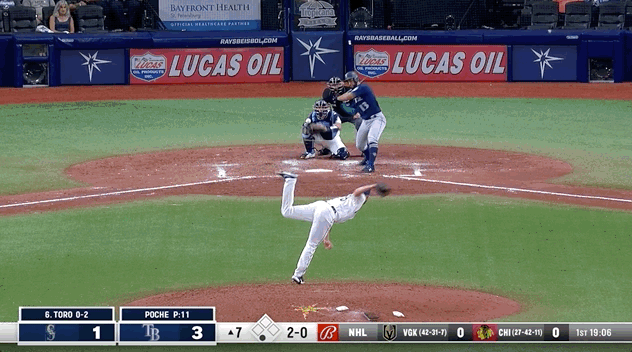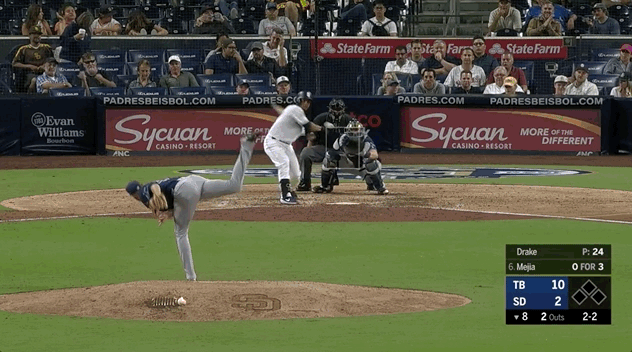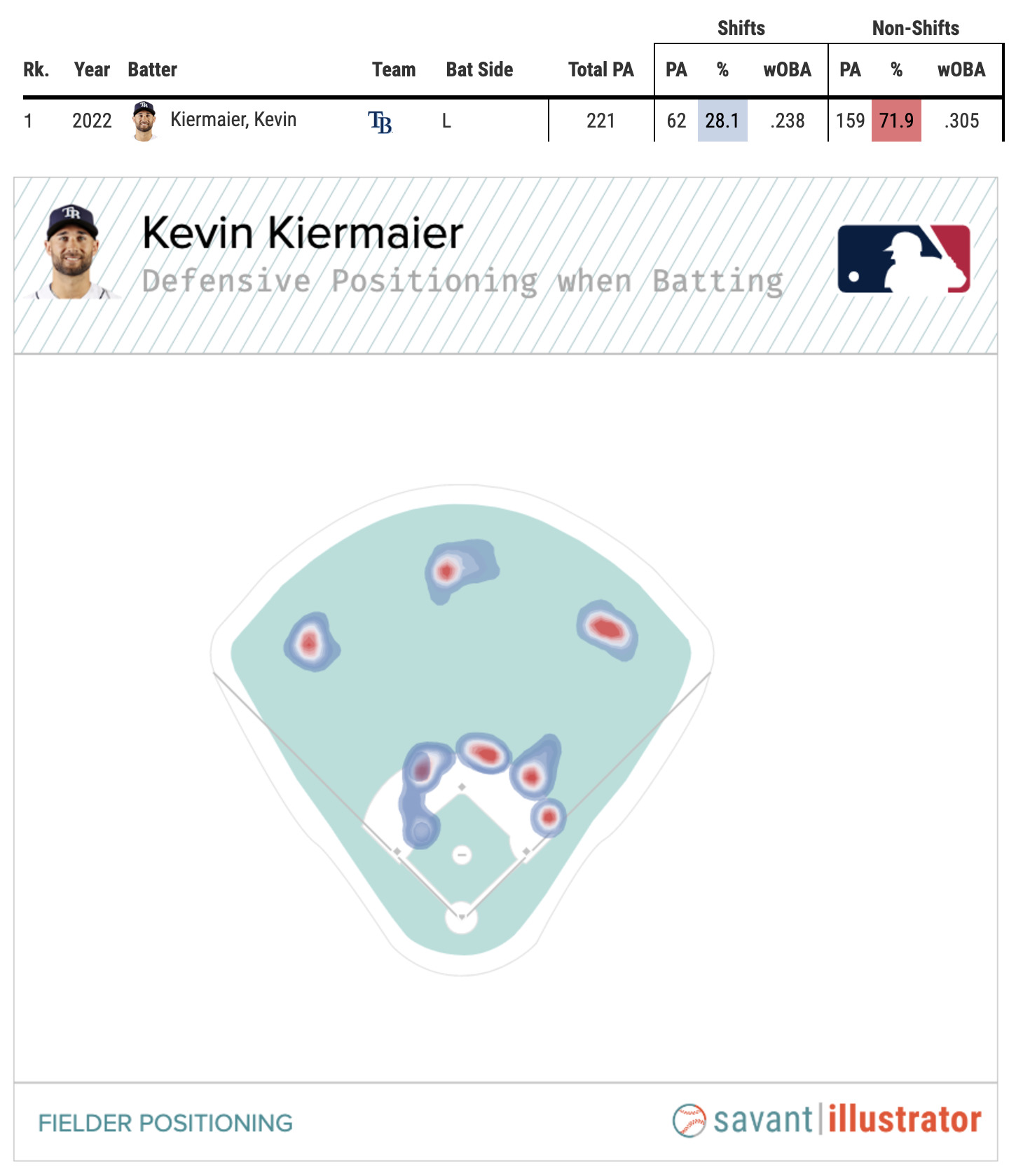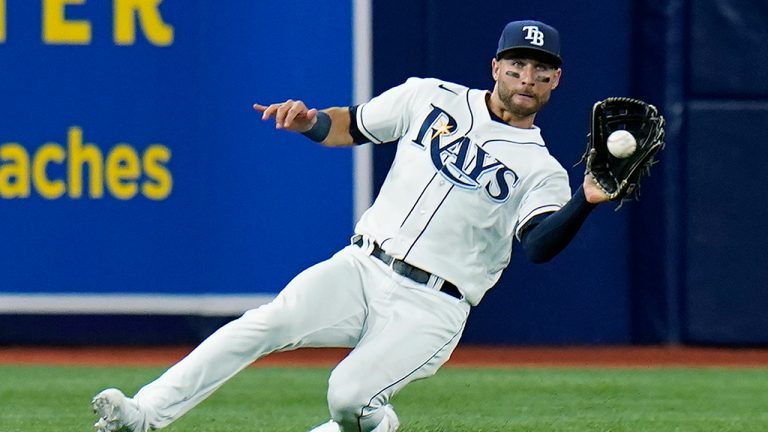The best way to think about what the Toronto Blue Jays are adding in Kevin Kiermaier, the left-handed hitting centre fielder the club’s finalizing a free agent deal with this week, is to imagine condensing Raimel Tapia, Jackie Bradley Jr., and Bradley Zimmer into one roster spot.
Last season, the Blue Jays gave that trio 614 combined plate appearances and 1,481 defensive innings, trying to leverage the strengths of each player’s profile while minimizing their flaws.
The club varied its offence with Tapia’s contact-heavy, left-handed bat early in games before lifting him defensively late. It leaned on Bradley’s flawless defence but seldom asked him to face a left-handed pitcher. It situationally utilized Zimmer’s defence and game-changing speed while rarely letting him near a consequential plate appearance.
Going forward, Kiermaier can provide all those traits with fewer limitations and at one-third the roster weight. That starts with the 400 plate appearances he’s positioned to inherit from Tapia. Kiermaier’s offensive approach is a bit different — less contact with more discipline, less raw power yet better game power, more balls in the air than on the ground — but the overall results are relatively similar. Tapia contributed a .672 OPS and 90 wRC+ to the Blue Jays last season. Since the start of 2020, Kiermaier’s OPS is .690, his wRC+ is 96.
Meanwhile, it was typically Zimmer or Bradley who took over defensively for Tapia late in close games. The Blue Jays particularly coveted the runs Bradley kept off the board as a centre fielder thanks in part to outfield jumps and arm strength that ranked within the top-10 per cent of the league. Kiermaier didn’t only grade within that rarefied defensive air himself — he rated even higher.
And in Zimmer, the Blue Jays carried one of MLB’s fastest runners — a late-game weapon who averaged 29.2 feet per second on the basepaths. How quick was Kiermaier in 2022? He averaged 29.2 feet per second himself, with an average home-to-first time a tenth of a second faster than Zimmer’s.
That’s the idea here. Kiermaier isn’t replacing Teoscar Hernandez. He’s condensing — arguably upgrading on — Tapia, Bradley, and Zimmer, helping create additional roster flexibility that can be utilized in a variety of ways to acquire other outfielders that help replace the offence Hernandez took with him to Seattle.
Will that mean betting on Michael Conforto’s return to play? Or Michael Brantley’s ability to avoid the injured list? Is there a more dependable option acquirable via trade such as Bryan Reynolds, Daulton Varsho, or Ian Happ? Does the club look to increase its versatility with someone like Adam Frazier, Brian Anderson, or Jurickson Profar? Is there a more creative bench construction of multiple part-timers with upside in some combination of Joey Gallo, Edwin Rios, Trey Mancini, or AJ Pollock?
We’ll see. The one piece of that puzzle we have so far is Kiermaier, who became a free agent this winter after the Rays bought out their $13-million 2023 club option on him for $2.5-million.
That was a near automatic decision for the low-payroll Rays with Jose Siri on hand to take over centre field, top prospect Josh Lowe nearing major-league readiness, and Kiermaier coming off a rocky 2022 season that ended in July with surgery to repair a torn labrum in his left hip.
Following surgery, Kiermaier said “it has been an absolute grind what I’ve played with this last year-and-a-half,” suggesting his hip issues originally arose sometime in 2021. He was clearly hampered by the ailment in 2022, receiving multiple cortisone shots, spending 10 days on the IL in June, and hitting .228/.281/.369 with a 90 wRC+ over 63 games prior to his surgery.
That obviously wasn’t the best or most representative sample of Kiermaier’s ability. So, what will he bring to the 2023 Blue Jays? Let’s take a look at each aspect of his game.
Defence
It isn’t hyperbolic to say Kiermaier’s been MLB’s best defensive outfielder since he entered the league in 2014. He’s second to only Mookie Betts over that span in ultimate zone rating (72.4 to Betts’ 89.3) and has him beat in defensive runs saved (134 to 129). That’s despite Kiermaier playing over 700 fewer innings and sticking at centre into his 30's while Betts moved to right.
And even in losing a step over the last near-decade, Kiermaier’s remained elite. He ranked among MLB’s 93rd percentile or higher in outs above average each season from 2017 through 2021. And although his 2022 was too condensed to consider advanced defensive metrics like those, the 32-year-old still demonstrated elite raw ones.
He averaged 92.5-m.p.h. on the top 10 per cent of his throws, which ranked 20th among outfielder arm strength. His 37.3 average feet per second while tracking down flyballs fell within MLB’s eight quickest defenders. And his burst — a statcast measure of acceleration that tracks the ground a player covers within the second 1.5 seconds of their route — was 1.8 feet better than average, a top-5 mark.

That explosive speed helps Kiermaier get some of the best outfield jumps you’ll see across the game. It expands the territory he covers, rendering opportunities at the edges of an average outfielder’s range routine, and letting him make attempts on balls many wouldn’t get near.
In 2021, Kiermaier ran down 81.3 per cent of the balls Statcast graded him as having an opportunity on — second only to Byron Buxton. Of all his opportunities, 40 had a catch probability between 26 and 75 per cent. Kiermaier caught 35 of them, an MLB-best rate.

It all comes together to make outfield defence Kiermaier’s greatest impact on a team’s win expectancy. A run prevented is equal to a run created. That’s how Kiermaier’s produced 9.1 fWAR over the last five seasons despite being a below-league-average hitter and missing substantial time due to injuries.
If there was ever a club that stands to benefit from that, it’s the Blue Jays. Toronto graded well below average in outfield DRS (-6), UZR (-17.1), and OAA (-3) last season. And those numbers could’ve been worse if not for the club’s aggressive deployment of four-man outfields and exaggerated shifts.
MLB’s shift restriction will limit Toronto’s ability to position defenders as optimally in 2023. But the addition of a superlative defender like Kiermaier, in tandem with the upgrade George Springer will provide over Hernandez as he plays more often in right field, ought to help make up for it and then some.

Offence
Kiermaier’s never been known for his bat and no one’s expecting him to power Toronto’s offence. The bet the Blue Jays are making is that, with his hip issues in the rearview, Kiermaier can be something closer to the .249/.310/.410 career hitter he was over his first eight years as a big-leaguer. Considering the 2022 league average was .243/.312/.395, that’s certainly playable.
But is even that a lofty expectation? Possibly. Kiermaier’s best season since 2017 was actually 2021 when his hip issues began. He finished that campaign with a .259/.328/.388 line, good for a 101 wRC+. Kiermaier was a below-league-average hitter each of the three seasons prior, including back-to-back 79 wRC+ efforts in 2018 and ’19. His career numbers are pulled up substantially by a strong, .262/.419/.431 line — good for a 107 wRC+ — over his first four MLB seasons. He’s posted an 87 wRC+ over the half-decade since.
The picture looks worse when you layer in Kiermaier’s increasing strikeout rate over that recent sample, which hit a career-high of 27.6 per cent in 2022. He struck out only 18.3 per cent of the time over his first three MLB seasons but has been running rates in the low-to-mid 20’s ever since. And the three highest strikeout rates of his career have come in the last three years. That’s a troubling trend.
Kiermaier has at least shown an ability to mix a decent number of free passes in with those strikeouts, posting a 12.6 per cent walk rate during pandemic-shortened 2020 followed by an 8.5 in 2021. But he was back down to 6.3 per cent in 2022, which lines up with his seven per cent career clip. That’s a fair expectation going forward.
There isn’t much in Kiermaier’s Statcast data to dream on, either. His average exit velocity and barrel rate over the last five seasons are well below-average, and while expected statistics suggest he deserved better outcomes than he saw for the quality of contact he made last season, the opposite was true in 2021 over a much larger sample. And even regressing positively to his 2022 expected statistics — .250 xBA, .388 xSLG, .305 xwOBA — wouldn’t make Kiermaier an above-average player, to say nothing of the lack of hard contact underlying those numbers.
Still, MLB’s shift restriction could help Kiermaier, who hit .172/.226/.310 with a .238 wOBA in the 26.8 per cent of total plate appearances he was shifted in over the last three seasons. He hit .250/.302/.392 with a .305 wOBA when not shifted over that span, which, again, isn’t dominant but is much more playable at the bottom of a lineup.

So, what’s a realistic expectation for Kiermaier offensively in 2023? Likely numbers around 10 per cent below league average over the 400 plate appearances he could make from the bottom-third of Toronto’s batting order. That’s essentially what Tapia provided the 2022 Blue Jays, batting .265/.292/.380 with a 90 wRC+ over 433 plate appearances.
Remember, that was on a 92-win team. Given the substantial defensive upgrade Kiermaier is over Tapia, the Blue Jays would be happy to take those offensive numbers again — assuming a more impactful outfield bat is added to the everyday mix ahead of him.
Baserunning
While he doesn’t reach first often enough to fully leverage it, Kiermaier provides excellent speed on the basepaths. His 29.2 feet per second sprint speed ranked among MLB’s 93rd percentile in 2022, and he finished in the top-5 per cent of the league each of the prior three seasons when he wasn’t playing through a hip issue. Combining that with consistent effort out of the box and innate savviness, Kiermaier remains one of MLB’s best at swiping an extra base from unsuspecting outfielders.

You can bet Blue Jays manager John Schneider will find plenty of use for that after demonstrating the aggressive baserunning approach he likes to deploy over the back-half of 2022. Through the first 88 games of the season with Charlie Montoyo as manager, the Blue Jays averaged .56 stolen base attempts per game. But over the final 74 games of the campaign played under Schneider, that rate jumped to .72 per contest. And, while reliable hit-and-run data remains hard to come by, the club certainly appeared more willing to utilize the tactic with Schneider at the helm.
Kiermaier hasn’t been stealing bases as frequently of late as he did in his 20’s, attempting only 30 over the last three seasons. But he has a 76.7 per cent success rate over that span, which is right in line with his career average. And in 2021, Kiermaier took an extra base — defined as advancing more than one base on a single or more than two on a double — in 57 per cent of his opportunities, a top-15 rate across MLB.
That tells you he’s just as cunning as ever when choosing his spots to run. Could MLB’s larger bases and new pick-off limit encourage him to take off more often in 2023? It wouldn’t be surprising. And with Schneider in charge, a shrewd veteran like Kiermaier is likely to have the green light whenever he wants it.
Health
You can debate whether or not health is a skill. But there’s no arguing that all of the above is moot if Kiermaier’s unable to take the field. And throughout his Rays tenure, availability was never certain.
Kiermaier appeared in 654 of Tampa’s 1,032 games over the last seven seasons — a mere 63.4 per cent. There was last year’s hip issue that required surgery; separate IL stints for quad and wrist ailments in 2021 followed by an off-season knee procedure; a left thumb sprain in 2019 suffered sliding headfirst into first base; a 2018 right thumb injury that cost him two months before a fractured foot ended his season; another two months missed in 2017 due to a hip fracture; multiple fractures in Kiermaier’s left hand that cost him 48 games in 2016. It’s a lot.
To his credit, the majority of Kiermaier’s injuries have resulted from his fearless, full-send approach and a willingness to sacrifice his body to produce good outcomes for his team. Here he is fracturing those bones in his left hand trying to make a play on a ball most centre fielders allow to drop in:
And here’s the hip fracture from 2017, suffered as Kiermaier went into a slide to try to beat out a routine groundball to first that had no business being a close play:
Watch enough Kiermaier video and you’ll find he isn’t only a danger to himself, but those around him. His range is so wide, and his desire to make every play so unrelenting, that he’ll occasionally barrel in front of right or left fielders and crash down upon shortstops or second basemen while pursuing fly balls. Like Springer, it’s evident Kiermaier has only one game speed — all-out. Regardless of any human being or stadium structure that may stand in his way.
You could argue that Kiermaier ought to be a bit more cautious and selective with his attempts at the near-impossible. But then you’re in the uncomfortable position of faulting effort. And is Kevin Kiermaier Kevin Kiermaier if he isn’t flying all over the field hunting down every last ball in play?
Ultimately, Kiermaier’s built his career making plays most players can’t. There’s probably a reason he’s the rare, WAR-producing veteran to exit the Rays organization via anything other than trade. He can fill a valuable role on a winning team. And if trying too hard to make plays is a flaw, it’s one you’ll stomach for his features.




 2:01
2:01


COMMENTS
When submitting content, please abide by our submission guidelines, and avoid posting profanity, personal attacks or harassment. Should you violate our submissions guidelines, we reserve the right to remove your comments and block your account. Sportsnet reserves the right to close a story’s comment section at any time.